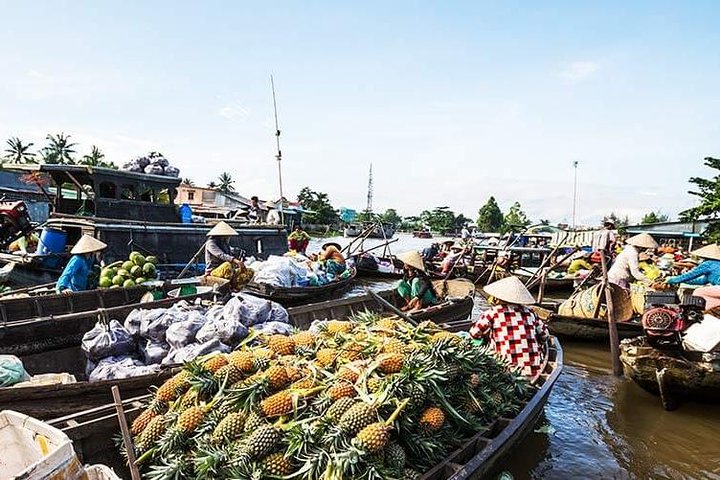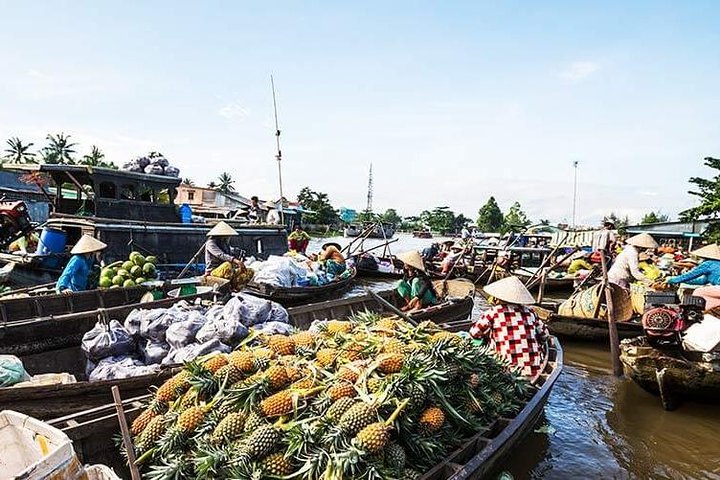Explore Cu Chi Tunnels and Mekong Delta: Crawl through historic tunnels, shoot iconic guns, savor local cuisine, and cruise lush canals. Book your adventure now!
Explore Cu Chi Tunnels and Mekong Delta: Crawl through historic tunnels, shoot iconic guns, savor local cuisine, and cruise lush canals. Book your adventure now!
-
Saigon Opera House (Ho Chi Minh Municipal Theater) - Standing magnificently at the heart of Saigon is the Saigon Opera House, which is also known as the Municipal Theater. The building stands as one of the impressive sight in Saigon – both night and day.
Saigon Opera House was built in 1898 by the French architect – Eugene Ferret, following the…
-
Saigon Opera House (Ho Chi Minh Municipal Theater) - Standing magnificently at the heart of Saigon is the Saigon Opera House, which is also known as the Municipal Theater. The building stands as one of the impressive sight in Saigon – both night and day.
Saigon Opera House was built in 1898 by the French architect – Eugene Ferret, following the “flamboyant” style of the French Third Republic. It was set to be two meters higher than the street surface with two door layers, in order to prevent traffic noise.
Located on the city’s center axis, connecting the metro station and roundabout in front of Ben Thanh market. From a distance, the Opera House looks like a beautiful gigantic city gate. The architecture boasts stone-carved ornaments and statues at the entrance, crystal chandeliers, and shiny granite floor at the lobby area – all built with materials imported from France.
We will start to visit Cu Chi tunnels from places which are surrounding here after picking you up. - Ben Dinh Tunnels - Your local guide will take you on a fascinating tour of the Cu Chi tunnels tour, where you will learn more about the conditions the people lived in, the hardships they faced, and the amazing ingenuity employed to maintain life in the tunnels. We walk past huge bomb craters - evidence of the heavy bombing campaigns in the region during the Indochina conflict, discover hidden entrances right beneath your feet, wander past tiny little chimneys in the ground that dispersed smoke from the underground kitchens, sample some of the simple cuisine that local fighters would have survived on, and have an opportunity to venture into the tunnels and explore the complex.
-
SƠN MÀI QUANG MINH - Handicap handicrafts factory: The high quality of resin from Vietnamese lacquer trees, notably those of the north, was a crucial factor in the rapid development of this art form.
Decorated lacquer statues, panels, boxes and trays may still be seen at many temples and pagodas.
In centuries the use of lacquerware was extended to larger items such as wooden chairs and tables, decorated with engraved, painted, inlaid mother-of-pearl designs.
By the 18th century important central for lacquerware production in the north and in the south.
As part of their strategy to open up Vietnamese handicrafts to new foreign markets, the French introduced formal training programmed in lacquerware at the School of Indigenous Arts near Saigon from 1901 and in Hanoi from 1930
Since that time lacquerware has continued to develop into one of the mainstays of the Vietnamese handicraft industry, both at home and abroad.
Lunch is including in this complex area before heading to Mekong Delta. -
Cafe Trúc Xanh - Silk is a natural protein fiber produced from the silkworm’s cocoon, and some forms can be woven into textiles. It takes around 3,000 silkworms consuming 104 kilograms of mulberry leaves to produce two pounds (one kilogram) of silk; the process lasts over three days. The result is a material that is light weight, soft and very absorbent, making it an ideal fabric for warmer countries.
Silk was once considered extremely luxurious and thus available only to noble families. Now the fabric is widely used, and beautiful silk products are affordably to anyone. Be weary of buying silk for prices lower than that since they can be of questionable quality.
A professional silk manufacturing enterprise that supplies silk not only to customers but also to designers in the Vietnam fashion market and also overseas. It exports fabric to Korea, Japan, Thailand, Denmark, France, England and the U.S., so you are guaranteed the real thing here. -
Thới Sơn - We board boat for a cruise on the Mekong River. Our first stop is at a bee farm, to gain an insight into one of the cottage industries in the region. On our Mekong tour, we will visit an island with lush tropical gardens where we have a chance to sample tropical fruit. Continuing to another island in the Mekong Delta, we will learn more about another cottage industry, coconut candy. We will take you to a factory and explain the process of making the sweet. As we meander down the Mekong, we will have a chance to visit local villages in the area and learn more about the traditional lifestyles, culture, and customs of people who call the Delta their home.
After that, we will travel to discover local life in incredible alleys hidden insight covered tropical fruit orchards and listen to traditional music which is called as folk music , from where we will transfer to a smaller rowing boat to help us get deeper into the smaller canals of the Delta. -
Saigon Opera House (Ho Chi Minh Municipal Theater) - Our tour guide and driver will bring you back Ho Chi Minh city.
I takes us about 1 hour 45 minutes to go back Saigon from Mekong Delta.

- Air-conditioned vehicle
- Bottled waters & lunch at local restaurant
- Pick up & Drop off from your hotel within district 1, HCMC
- English speaking tour guide
- Air-conditioned vehicle
- Bottled waters & lunch at local restaurant
- Pick up & Drop off from your hotel within district 1, HCMC
- English speaking tour guide
- Tips/ gratuities, personal expenses
- You will be collected around 7 - 10 USD/ each for picking outside of district 1
- Tips/ gratuities, personal expenses
- You will be collected around 7 - 10 USD/ each for picking outside of district 1
Arrive at the Cu Chi tunnels to delve into the detailed history of the war from a Vietnamese perspective. Your first stop includes sightseeing in villages, rubber plantations, and rice paddies. You’ll also get to experience life inside the tunnel system and walk through the jungle in the tunnel area, with an opportunity to crawl inside the tunnels….
Arrive at the Cu Chi tunnels to delve into the detailed history of the war from a Vietnamese perspective. Your first stop includes sightseeing in villages, rubber plantations, and rice paddies. You’ll also get to experience life inside the tunnel system and walk through the jungle in the tunnel area, with an opportunity to crawl inside the tunnels. Additionally, you can shoot the AK47, M16, M30, M60, Garand M1, and Carbine (at your own expense). After visiting the Cu Chi tunnels, you will be transferred to a restaurant for lunch before visiting a handicraft factory run by individuals with disabilities, which is part of the historical experience. Following this, our driver and tour guide will take you to the Mekong Delta to explore a traditional coconut candy workshop or honey bee farm, listen to traditional folk music, and enjoy the lush beauty of the Mekong Delta by electric car. You’ll also take a cruise along the river and row in a sampan through the shady, breezy canals under the green canopy of water coconut trees.
- The remaining hours are allotted for the travel time
- Everyone can join this tour
For a full refund, cancel at least 24 hours before the scheduled departure time.
For a full refund, cancel at least 24 hours before the scheduled departure time.






















